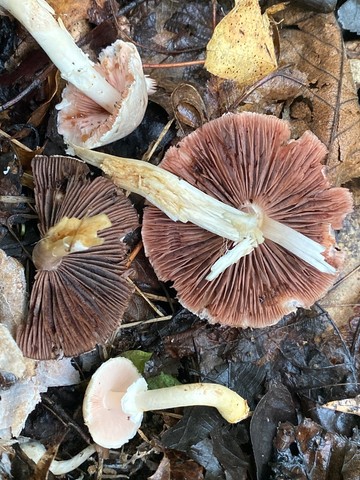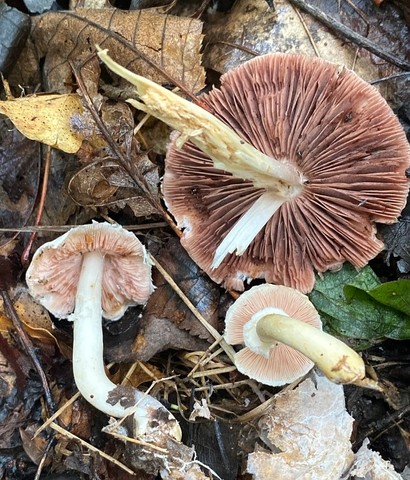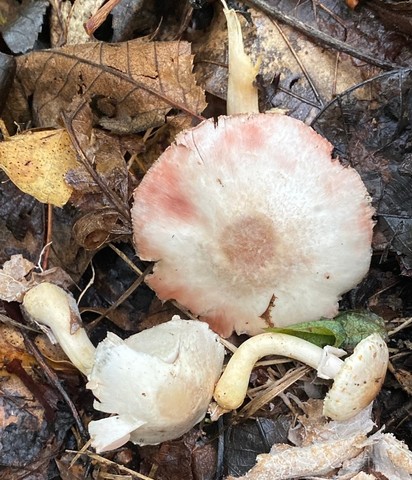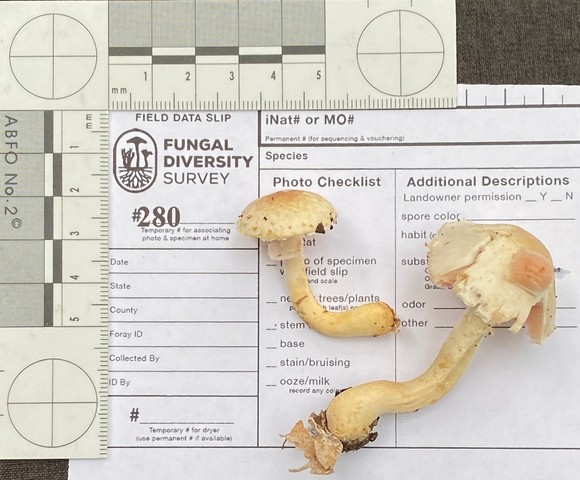Kerrigan's Champion
Agaricus kerriganii
Life > Fungi > Basidiomycota > Agaricomycotina > Agaricomycetes > Agaricomycetidae > Agaricales > Agaricineae > Agaricaceae > Agaricus
Description
Kerrigan's Champion (Agaricus kerriganii) is a brown-spored gilled mushroom that grows in soil in wooded habitats. It can be found from late summer to early fall in Oak and Pine forests. It has a skirt on the stem without a cup at the stem base. It bruises yellow.
Morphology
- Cap shape evenly rounded to half-sphere, later becoming flat to centrally depressed with age. 1.5-2.5 inches (4-6 cm) wide.
- Texture smooth and dry. Ornamentation can be silky to scaly. Grayish brown becoming more brown towards the center of the cap.
- The gills are free from the stem. The gill color is light pink when young, becoming darker pink, then becoming brown with age. This is due to brown spores maturing on the gill surface over time.
- Stem with a membranous skirt on the top half and a bulb on the base. Sometimes curved. 1.2-2 inches (3-5 cm) long.
- Bruising yellow where handled. Bruising red with age and decomposition.
- Spore print brown.
Observations
August 8th, 2023 Indian Cave State Park

280
Growing gregariously on soil in open, mixed oak/hickory woodland hilltop.
- Gills light pink on young specimens turning dark pink then chocolate brown.
- Cap surface bruising red.
- Smell: pleasant
- Taste: Pleasant
- Annulus present, no volva.
- Base of stipe bruising yellow.
- Stipe base bulbus.
- KOH: flashing highlighter yellow for a few minutes, then dull gray
- Ammonia: Indistinct
Additional: Young specimens collected. Old, degraded specimens left in field.
AAGTCGTAACAAGGTTTCCGTAGGTGAACCTGCGGAAGGATCATTATTGAATTATGTTTCTAAATGGGTTGTAGCTGGCTCTGTAGAGCATGTGCACACCCGTTTGGACTTCATTTTCATCCACCTGTGCACCTATTGTAGTCTTTGGTTGGGTATCGAGGAAGTGGTCAGCCTATCAGCATTTGCTGGATGTGAGGACTTGCAGTGTGAAAGCTTTGCTGTCCTTTACTTGACCCCGGAGTCGTGTTCTCACCAGAGTCTATGTTATTCATTATACCCTGTCGAATGTCATTGAATGTCTTTACATGGGCTTCTATGCCTATGAAAATCATAATACAACTTTCAGCAACGGATCTCTTGGCTCTCGCATCGATGAAGAACGCAGCGAAATGCGATAAGTAATGTGAATTGCAGAATTCAGTGAATCATCGAATCTTTGAACGCATCTTGCGCTCCTTGGTATTCCGAGGAGCATGCCTGTTTGAGTGTCATTAAATTCTCAACTCTCTTATACTGTTTTGTATAGGAGAGCTTGGATTGTGGAGGTTTGCTGGCCGCTCGTTTGAGGTCAGCTCCTCTGAAATGCATTAGCGGAACCGTTTGCGATCTGTCACAAGTGTGATAAATTATCTACACTGGCGAGGGGATTGCTCTGTGTTGTTCAGCTTCTAATTGTCTCTACTTTGTGGGACTAACTTTTTGAATACTTGACCTCAAATCAGGTAGGACTACCCGCTGAACTTAAGView MycoMap DNA Results
References
Kalichman, J. (2023). Names - Agaricus & Agaricales. Retrieved January 17, 2025, from Agaric.us website: https://agaric.us/common_names/names.html
Kuo, M. (2018, April). The genus Agaricus. Retrieved from the MushroomExpert.Com Web site: http://www.mushroomexpert.com/agaricus.html
Muñoz, Guillermo & Palazón, Antonio. (2019). Ten rare or little-known species collected in the Iberian Peninsula. https://www.researchgate.net/publication/361879979_Ten_rare_or_little-known_species_collected_in_the_Iberian_Peninsula
Created December 15, 2025 at 10:41 AM



